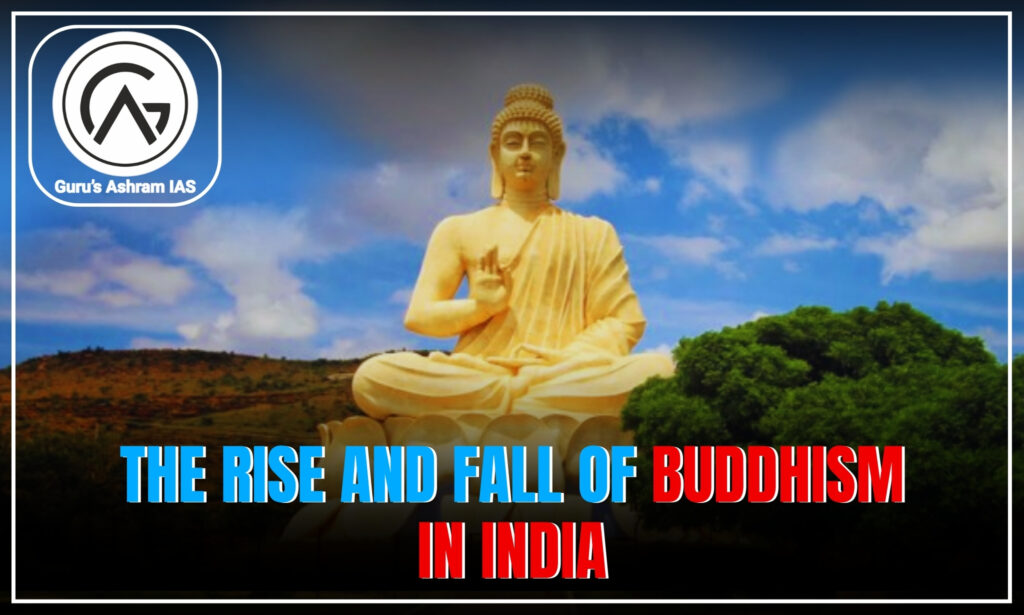The rise and fall of Buddhism in India – the Brahmin conspiracy?
The rise of Buddhism in India:
R.S. Sharma emphasized that Buddhism emerged as a reaction to socio-economic inequalities and ritualistic Brahmanism of the Later Vedic age. In his work “India’s Ancient Past”, he stresses the importance of new urban centres and the rise of the Vaishya class in promoting heterodox movements.
- Timeframe: Around 6th century BCE (567 BC), during the Later Vedic period.
- Region: The eastern Gangetic plain—especially in areas like Magadha and Kosala.
- Founder: Siddhartha Gautama (later known as the Buddha), a prince of the Shakya clan in Lumbini (modern-day Nepal).
- Original Name – Siddhartha.
- Father – Suddho-dana: Chief of Sakya clan > State: Kosala; Capital – Kapilavasthu
- Mother – Maya died 7 days after his birth; belonged to Koliya Dynasty.
- Wife – Yasodhara
- Son – Rahul (only one child)
Four holy sites of Buddhism:
- Born: Lumbini, Nepal.
- Enlightenment: Gaya under Bodhi (Pipal) tree, Bihar, here Mahabodhi temple is made.
- First teaching: Sarnath, UP
- Died (Maha-pari-Nirvana): Sal tree, Kushinagar, UP
Causes for the Rise of Buddhism
-
Social Discontent with Brahmanism:
- The Vedic religion was dominated by Brahmins, who performed expensive rituals.
- The caste system created social inequalities, especially against Shudras and women.
- Buddhism offered equality, compassion, and a rational path to liberation.
- Dr. B.R. Ambedkar argued that Buddhism was a revolt against Brahminical supremacy and the oppressive caste hierarchy. In his book “The Buddha and His Dhamma”, Ambedkar sees the Buddha as a social reformer as much as a spiritual teacher.
-
Economic and Political Factors:
- Urbanization and trade were on the rise—new merchant classes (Vaishyas) sought spiritual alternatives.
- Romila Thapar highlights the role of Magadhan rulers like Bimbisara, Ajatashatru, and later Ashoka in institutionalizing and spreading Buddhism as a state-supported ideology.
-
Philosophical Appeal:
- Buddhism emphasized ethical living, self-effort, and freedom from ritualism.
- Its Four Noble Truths and Eightfold Path provided a clear moral framework.
-
Use of Pali Language:
- Unlike Sanskrit-based Vedic texts, Buddha preached in Pali—the language of the masses.
- This made his teachings accessible to common people.
-
Role of Monastic Sangha:
- The Buddhist Sangha (monastic community) was well-organized and helped spread teachings.
- Monks acted as educators, missionaries, and healers.
Core Teachings of Buddhism
-
Four Noble Truths:
- Dukkha: Life is full of suffering.
- Samudaya: Desire is the cause of suffering.
- Nirodha: Cessation of suffering is possible.
- Magga: The path to cessation is the Eightfold Path.
-
Eightfold Path:
- Right View, Right Intention, Right Speech, Right Action, Right Livelihood, Right Effort, Right Mindfulness, Right Concentration.
-
Rejection of Brahmanical Ideas:
- No acceptance of creator god, sacrifices, or soul (atman).
- Belief in Anatta (no-self) and Anicca (impermanence).
Spread of Buddhism
A.L. Basham, in “The Wonder That Was India”, writes that Buddhism was the first missionary religion in the world and attributes much of its spread to Ashoka’s moral and administrative reforms. Lamotte Étienne, a French scholar, documented the spread of Buddhism to Central Asia and China, emphasizing the translation efforts and syncretism with local cultures.
-
Ashoka the Great (3rd century BCE):
-
- Converted to Buddhism after the Kalinga War.
- Sponsored missionaries to Sri Lanka, Central Asia, Greece, and Southeast Asia.
- Built stupas, viharas, and inscribed edicts with Buddhist values.
-
Trade Routes:
- Buddhism spread along the Silk Road, influencing China, Korea, Japan, and Tibet.
Early Buddhist Councils
- 1st Council (Rajagriha) – Shortly after Buddha’s death, under Ajatashatru.
- 2nd Council (Vaishali) – Debate over monastic discipline.
- 3rd Council (Pataliputra) – During Ashoka’s reign, organized missions abroad.
- 4th Council (Kashmir) – Under Kanishka, Mahayana Buddhism emerged.
K.T.S. Sarao: Suggests that the First and Second Councils were less about doctrine and more about monastic discipline and organizational control. Heinz Bechert (German Indologist) discusses the Third and Fourth Councils as moments of sectarian consolidation, particularly the rise of Mahayana Buddhism under Kanishka.
Branches of Buddhism
-
Theravada (Hinayana):
- Conservative, focuses on individual enlightenment.
- Popular in Sri Lanka, Myanmar, Thailand.
-
Mahayana:
- Emphasizes Bodhisattva path (helping others attain Nirvana).
- Flourished in China, Japan, Korea, Vietnam.
-
Vajrayana (Tantrayana):
- Developed in Tibet.
- Focus on rituals, mantras, and esoteric practices.
Factors responsible for the decline of Buddhism of the India
- Decline in Royal Patronage: Historian Romila Thapar argues in “A History of India” that the decline of Buddhism was closely tied to shifts in political patronage. After the Mauryan Empire (particularly post-Ashoka, 3rd century BCE), dynasties like the Guptas (4th–6th centuries CE) favoured Vedic traditions, redirecting resources to Hindu temples and Brahminical institutions.
-
Integration into Hinduism:
-
-
- Johannes Bronkhorst, in “Buddhism in the Shadow of Brahmanism”, argues that Hinduism absorbed Buddhist practices, such as meditation and ethical principles, diluting Buddhism’s distinct identity. He highlights how the Buddha was incorporated as an avatar of Vishnu in texts like the Vishnu Purana, a process that Richard Gombrich (Theravada Buddhism) describes as a strategic assimilation by Brahminical traditions to counter Buddhism’s appeal.
- Heinrich Zimmer (Philosophies of India) points out that the philosophical convergence between Mahayana Buddhism and Advaita Vedanta, particularly under Shankaracharya, made Buddhism less distinct for lay followers.
-
-
Rise of Bhakti Movements:
-
-
- A.L. Basham, in “The Wonder That Was India”, notes that the emotional appeal of bhakti movements, emphasizing devotion to deities like Vishnu and Shiva, contrasted with Buddhism’s monastic and intellectual focus. This shift drew the masses toward Hinduism, as bhakti offered accessible rituals.
-
-
Muslim Invasions and Destruction of Monasteries:
-
-
- Peter Harvey, in “An Introduction to Buddhism”, cites the destruction of key monasteries like Nalanda and Vikramashila (circa 1200 CE) by Muslim invaders, such as Bakhtiyar Khilji, as a critical blow. He notes that these invasions disrupted Buddhist institutional networks, scattering monks and texts.
-
-
Internal Factors within Buddhism:
-
- Richard Gombrich argues that the rise of Vajrayana Buddhism, with its esoteric and tantric practices, alienated some followers who found it complex compared to early Buddhist teachings. Eleanor Zelliot, in “Ambedkar’s World”, notes that internal schisms between Mahayana, Theravada, and Vajrayana sects fragmented Buddhist unity.
The “Brahmin Conspiracy Narrative: Scholarly Critique
Brahmin philosophers like Shankaracharya (8th–9th century CE) challenged Buddhist doctrines through debates, promoting Advaita Vedanta. However, these were intellectual contests, not evidence of a conspiracy.
- Romila Thapar dismisses the conspiracy narrative, arguing in “Early India” that Brahminical influence grew organically as Hinduism adapted to social needs, incorporating Buddhist elements. She cites the lack of textual or archaeological evidence for systematic Brahmin-led persecution.
- D.N. Jha, in “Rethinking Hindu Identity”, argues that Pushyamitra Sunga had a proper army to destroy Buddhist temples and he supported Vedic sacrifices. However, evidence of widespread anti-Buddhist violence is exaggerated in later Buddhist texts like the Divyavadana.
Actually, according to Dalit scholar Gail Omvedt, Brahminism carried out a strategic adaptation to compete with Buddhism’s social appeal. For example, though cow have been sacred in Vedic text but was later forgotten due to rise of ritual sacrifices in various regions but the challenge of Buddhism led to readoption of Holy Cow in Buddhism.
So, in conclusion it can be said that Buddhism’s decline was a multifaceted process driven by economic, political, cultural, and religious factors, not a single Brahminical conspiracy. Although brahmins did carry out strategic moves to counter the challenge of Buddhism.
The rise of political Buddhism in Modern India – the Ambedkarite Politics
B.R. Ambedkar (1891–1956), a jurist, economist, social reformer, and the architect of India’s Constitution, was born into a Dalit family and experienced caste discrimination firsthand. His lifelong mission was to dismantle the caste system and secure dignity and equality for marginalized communities. By the 1930s, Ambedkar began exploring religious conversion as a strategy to escape the oppressive framework of Hinduism, which he saw as inherently tied to caste hierarchy.
Critique of Hinduism:
- In works like Annihilation of Caste (1936), Ambedkar argued that Hinduism’s caste system, rooted in texts like the Manusmriti, perpetuated Dalit subjugation. He famously declared, “I was born a Hindu, but I will not die a Hindu.”
- Gail Omvedt, in “Ambedkar: Towards an Enlightened India”, notes that Ambedkar viewed Hinduism as structurally incapable of reform due to its scriptural sanction of caste. This led him to seek an alternative religion that aligned with equality and rationalism.
Choice of Buddhism:
- Ambedkar chose Buddhism after studying various religions, including Islam, Christianity, and Sikhism, because it offered a rational, egalitarian, and indigenous framework. He was drawn to the Buddha’s rejection of caste, emphasis on ahimsa (non-violence), and focus on self-reliance.
- Ambedkar saw Buddhism as a “religion of liberation” that could provide Dalits with a new identity, free from the stigma of untouchability.
Mass Conversion of 1956:
- On October 14, 1956, Ambedkar, along with approximately 500,000 followers, converted to Buddhism in a public ceremony in Nagpur, Maharashtra. This event, known as the Diksha ceremony, marked the formal revival of Buddhism in India after centuries of decline.
- Surinder S. Jodhka in “Caste in Contemporary India”, describes this conversion as a political act of resistance, redefining Dalit identity and challenging Brahminical hegemony.
Rise of Political Buddhism/Neo-Buddhism:
Ambedkar’s conversion catalyzed the rise of political Buddhism, which blended religious identity with social and political activism. This movement, often called Neo-Buddhism, had distinct characteristics:
Valerian Rodrigues, in “The Essential Writings of B.R. Ambedkar”, notes that Ambedkar’s Buddhism was inherently political, aiming to create a collective identity for Dalits to demand rights and representation in a caste-dominated society.
Ambedkar’s conversion inspired the formation of Buddhist organizations and political movements, particularly in Maharashtra, where the majority of converts were from the Mahar caste (Ambedkar’s own community). The Republican Party of India (RPI), founded by Ambedkar in 1956, became a vehicle for Dalit political assertion, often invoking Buddhist principles. The vows are as follows, based on historical records and Ambedkar’s own writings:
- I shall have no faith in Brahma, Vishnu, and Mahesh, nor shall I worship them.
- I shall have no faith in Rama and Krishna, who are believed to be incarnations of God, nor shall I worship them.
- I shall have no faith in Gauri, Ganapati, and other gods and goddesses of Hindus, nor shall I worship them.
- I do not believe in the incarnation of God.
- I do not and shall not believe that Lord Buddha was the incarnation of Vishnu. I believe this to be sheer madness and false propaganda.
- I shall not perform Shraddha nor offer Pinda [Hindu rituals for the dead].
- I shall not act in a way violating the principles and teachings of the Buddha.
- I shall not allow any ceremonies to be performed by Brahmins.
- I shall believe in the equality of man.
- I shall endeavor to establish equality.
- I shall follow the Noble Eightfold Path of the Buddha.
- I shall follow the ten Paramitas prescribed by the Buddha.
- I shall have compassion and loving-kindness for all living beings and protect them.
- I shall not steal.
- I shall not tell lies.
- I shall not commit carnal sins.
- I shall not take intoxicants like liquor, drugs, etc.
- I shall endeavor to follow the Noble Eightfold Path and practice compassion and truthfulness in everyday life.
- I renounce Hinduism, which disfavors humanity and impedes the advancement and development of humanity because it is based on inequality, and adopt Buddhism as my religion.
- I firmly believe the Dhamma of the Buddha is the only true religion.
- I consider that I have taken a new birth.
- I solemnly declare and affirm that I shall hereafter lead my life according to the teachings of Buddha’s Dhamma.




